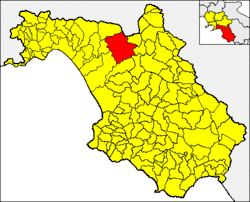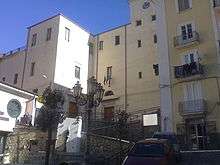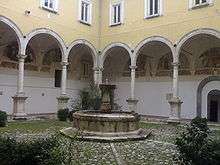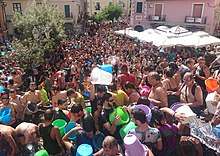Campagna
| Campagna | ||
|---|---|---|
| Comune | ||
.jpg) General view of the town | ||
| ||
 Campagna within the Province of Salerno | ||
 Campagna Location of Campagna in Italy | ||
| Coordinates: 40°40′N 15°6′E / 40.667°N 15.100°E | ||
| Country | Italy | |
| Region | Campania | |
| Province | Salerno (SA) | |
| Frazioni | Camaldoli, Galdo, Mattinelle, Puglietta, Quadrivio, Romandola-Madonna del Ponte, Santa Maria La Nova, Serradarce. | |
| Government | ||
| • Mayor | Biagio Luongo | |
| Area | ||
| • Total | 135.41 km2 (52.28 sq mi) | |
| Elevation | 270 m (890 ft) | |
| Population (2009) | ||
| • Total | 16,183 | |
| • Density | 120/km2 (310/sq mi) | |
| Demonym(s) | Campagnesi | |
| Time zone | UTC+1 (CET) | |
| • Summer (DST) | UTC+2 (CEST) | |
| Postal code | 84022 | |
| Dialing code | 0828 | |
| Patron saint | Antoninus of Sorrento | |
| Saint day | 14 February | |


Campagna (Italian: pronounced [kamˈpaɲɲa]) is a small town and comune of the province of Salerno, in the Campania region of Southern Italy. In 2010, its population was 16,183.[1]
History
The town, located in a mountainous district, gradually lost importance in the 20th century. All its district offices have been moved to other cities since the 1930s, and the Diocese of Campagna merged with the Archdiocese of Salerno in 1973.
During World War II, the Campagna was the site of an internment camp. The Bishop Giuseppe Maria Palatucci turned the camp into a shelter for Italian and foreign Jews, many of them sent there for protection by his nephew Giovanni Palatucci; Giovanni was later honored as a Righteous Among the Nations by the Yad Vashem Holocaust Memorial. Much of this is documented in Elizabeth Bettina's book, It Happened in Italy.
Geography
Campagna borders with Acerno, Contursi Terme, Eboli, Olevano sul Tusciano, Oliveto Citra, Postiglione, Serre and Senerchia (this one in the Province of Avellino),
The municipality counts the frazioni of Camaldoli, Galdo, Mattinelle, Puglietta, Quadrivio, Romandola-Madonna del Ponte, Santa Maria La Nova and Serradarce. Other localities are Avigliano, Folcata, Oppidi-Varano, Saginara and Sant'Angelo.
Tourist destinations
Castles, palaces, fountains and bridges
- Castle Gerione (10th century)
- Castle De Alegisio (10th century)
- Palazzo di Città (13th century)
- Palace Ducale Pironti (1694)
- Palazzo Tercasio (14th century)
- Palazzo dei Governatori dei Principi di Monaco (15th century)
- Palazzo Rivelli (14th century-17th century)
- Palazzo Pastore-Alinante (16th century)
- Palazzo Bernalla (14th century)
- Palazzo Trotta (16th century)
- Fountain Giudeca (15th century)
- Fountain S.Lucia (15th century)
- Fountain Cortiglia (15th century)
- Bridge of Presbyteres (15th century)
- Bridge of piazza Guerriero (15th century)
Churches, religious buildings and structures
- Basilica co-cathedral of Santa Maria della Pace (1112-1683)
- Church and convent Dominican of San Bartolomeo (14th century)
- Shrine of Madonna di Avigliano (1377)
- Church of SS. Annunziata (13th century)
- Church of SS Salvatore e Sant'Antonino (11th century)
- Church of S.Giovanni (16th century)
- Seminary di S. Spirito (15th century)
- Monastery of Maddalena (14th century)
- Church and convent of Osservanti della Concezione (15th century)
- Abbey of Santa Maria La Nova (1220–1249)
- Monastery of San Martino (16th century)
- Hermitage of S.Erasmo e S.Giacomo degli eremiti (11th century)
- Hermitage of San Michele di Montenero (12th century)
- Hermitage of S. Maria Domenica (16th century)
Museums
- Itinerario della Memoria e della Pace
- Museo della confraternita dei cinturati di Santa Maria del Soccorso
Nature reserve
- Oasi naturale del Monte Polveracchio
- Oasi di Persano
- Riserva naturale Foce Sele-Tanagro
Notable people
- Antoninus of Sorrento, catholic saint born at Campagna
- Honoré I, Lord of Monaco, Marquis of Campagna
- Charles II, Lord of Monaco, Marquis of Campagna
- Hercule, Lord of Monaco, Marquis of Campagna
- Honoré II, Prince of Monaco, Marquis of Campagna
- Juan Caramuel y Lobkowitz, bishop of Campagna
- Louis I, Prince of Monaco, Marquis of Campagna
- Giordano Bruno philosopher Dominican monk
- [[Julius Caesar Capaccio historical of Campagna
- [[Melchiorre Guerrriero noble of Campagna
Culture

Campagna hosts a traditional 'A Chiena (Italian: La Piena, English: The River Flood) festival annually in mid-August. During the festival, the river Tenza is deflected from its natural course through the city streets, becoming a stream where locals and tourists refresh themselves by throwing bucketfuls onto each other.[2] The festival has an ancient origin, although it was originally organized in order to wash the city streets and shops.[3]
Sister city
Monte Carlo in the Principality of Monaco is Campagna's sister city.
References
- ↑ (in Italian) Source: Istat 2010
- ↑ ""A Chiena" water festival". Euronews. Retrieved 16 February 2018.
- ↑ "Continua a Campagna 'A Chiena': secchiate, balli e folklore con i piedi nell'acqua". Salernonotizie. 23 July 2017. Retrieved 16 February 2018.
External links
![]()
- Official website (in Italian)
- Comuni italiani: Campagna (in Italian)
-Stemma.png)